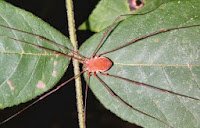 I believe last year, just about this time, I wrote a blog on
the “constancy of butterflies” for truly, the first year I was here, there wasn’t
a month that passed that didn’t feature some species being omnipresent in the
yard. Then, this year, when I was all
set to lay out the plates of smashed bananas for the Red Admiral butterflies, I
was disappointed to find only a handful were about. Summer slipped by with Pipevine Swallowtails
skittering about the ground looking for pipevine to lay eggs on, but no where
near the numbers that had been present that first summer. So, earlier this year I wrote about the NOT
so constant butterflies.
I believe last year, just about this time, I wrote a blog on
the “constancy of butterflies” for truly, the first year I was here, there wasn’t
a month that passed that didn’t feature some species being omnipresent in the
yard. Then, this year, when I was all
set to lay out the plates of smashed bananas for the Red Admiral butterflies, I
was disappointed to find only a handful were about. Summer slipped by with Pipevine Swallowtails
skittering about the ground looking for pipevine to lay eggs on, but no where
near the numbers that had been present that first summer. So, earlier this year I wrote about the NOT
so constant butterflies.
Ah, but I spoke too soon, for today, while cutting grass, I
noticed the locquat tree was in bloom, and was once again it is THE hang out
spot for several different species of butterflies. Plus the tree was swarming with bees,
beetles, and those flies that want you to think they are bees. What an entomological bonanza!
To be honest, butterflies have been abundant for the last
few weeks. We had a huge rain a three
weeks ago now, as happened last year, there was an explosion of snout
butterflies, flying low, flying high, flying in butterfly squadrons seemingly
from north to south, although they don’t really migrate, they surely appeared to be heading somewhere
together. The Queen butterflies that I
also have written about were back feasting on the blue mist flowers, and mixed
in with them, on occasion, were a few, a very few Monarchs. They are sadly said to have been at their
lowest numbers ever this year in Mexico.
It was a delight to see them all, yet they have once again
set me back on any sense of Thanksgiving and Christmas being on the
horizon. I had worked so hard to
convince myself it was “peanut butter ball making” season this morning, playing
Manheim Steamroller and pretending the gray clouds had a promise of snow in
them. But then, out I went to cut the
grass, and with the air alive with butterflies, I have been transported back to
a summer frame of mind. And the sun is
out. And it is climbing into the 80’s. What's a person to do but go with the butterfly flow? In a month I will be in Maine and I will have no trouble at all imagining I am at the North Pole!


















































